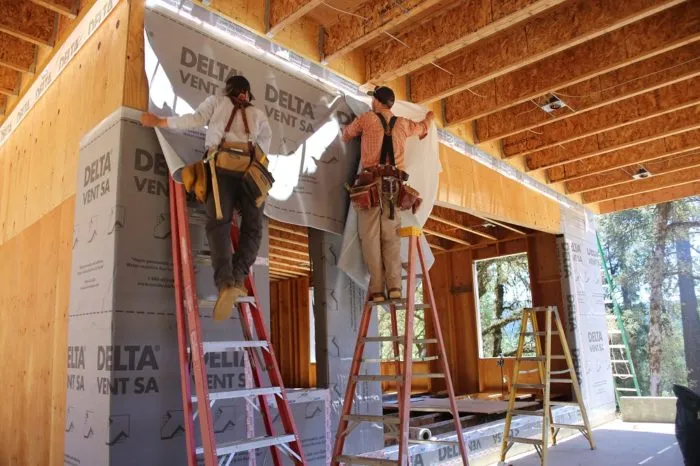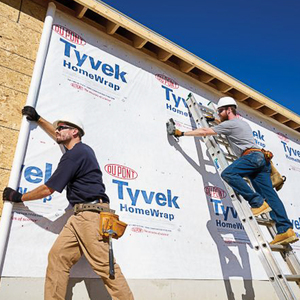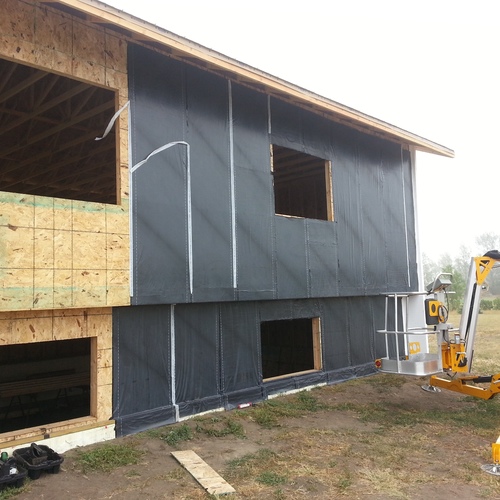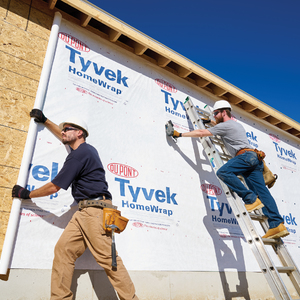
Water resistive barriers (WRBs) come in several types. The words “mechanically applied” make the standard nailed or stapled water resistive barriers sound more hi-tech than they are. No. 15 asphalt felt (Type I asphalt-saturated felt, ASTM D226) qualifies as a time-tested, inexpensive, and reliable WRB with certain advantages. In addition to shedding bulk water behind the exterior cladding, asphalt-impregnated felt acts as a blotter, which means it holds back bulk water while allowing vapor to evaporate.
Today, WRBs include liquid-applied and self-stick membranes and those integrated into the structural sheathing, such as HUBER’s Zip System. Whichever WRB you choose, they all have the same purpose: to shed bulk water and reduce air infiltration through the exterior walls. In short, these products provide a second line of defense between cladding and framing to protect your building from moisture. By far, the most common type of WRB comes in a roll and gets nailed or stapled onto the exterior sheathing. This type is the so-called mechanically applied water resistive barrier. Given the many options, let’s look at the different products from which to choose.
| The International Residential Code (IRC) defines a water resistive barrier as: “A material behind an exterior wall covering that is intended to resist liquid water that has penetrated behind the exterior covering from further intruding into the exterior wall assembly.” |
Asphalt-impregnated felt
Asphalt-impregnated felt ($) is the least costly yet effective WRB permitted by code. As the original “smart WRB,” the permeance of asphalt felt ranges from 5 to 60 perms depending on humidity. It can hold bulk water and then allow it to evaporate to the exterior. Its heavy-paper base was once made of recycled rags; today it is recycled cardboard. From the manufacturing perspective, it has green bona fides. Unfortunately, it acts only as a…
Weekly Newsletter
Get building science and energy efficiency advice, plus special offers, in your inbox.

This article is only available to GBA Prime Members
Sign up for a free trial and get instant access to this article as well as GBA’s complete library of premium articles and construction details.
Start Free TrialAlready a member? Log in















14 Comments
I am curious about your painful experience putting tyvek over the rafters... this was done in the cover story of Issue 299 Fine Homebuilding (A New Take on Insulating a Roof), and I was planning to do this on my addition roof. My addition is only ~550 ft2, so maybe some hassle is ok. What were the challenges and was there anything you would do differently next time?
The system shown in that photo is the Tyvek AtticWrap system, which was around in the mid-2000's, if my memory serves correctly. I thought it was an elegant system hygrothermally--providing a super vapor-open cavity above the insulation, that allowed for substantial ventilation drying.
https://www.buildsite.com/pdf/duponttyvek/Tyvek-AtticWrap-Technical-Notes-219822.pdf
I can't speak to Fernando's experiences, but in the test installations we were involved with, one of the big issues was not having a walkable surface until the sheathing was installed, so it was a matter of working your way up the roof incrementally, rather than the roofer throwing down sheets of OSB and nailing them off. Also, another issue was that the plastic U-shaped clips used to hold down the AtticWrap and create the cavities were not strong enough to resist the force of blown in insulation. They would deform, letting the AtticWrap go flat, and crushing the cavity.
Precisely, the installation was painfully slow and error-prone. Now, had this become something we continued doing, no doubt we would have figured the best way. But I don't see the system installed anywhere so I presume there's a good reason it never took off.
James,
I doubt that sort of assembly will ever gain much widespread acceptance. Production building has evolved a sequence of construction and details that allow the framing crew to working largely unimpeded by other trades until the structure is complete.
As Kohta said, It would have to be a pretty accessible and simple roof for me to be comfortable working on house-wrap with no sheathing below. I just finished two 3/12 roofs which had metal on strapping. They were fine to frame but we had a couple of close calls installing the panels once the underlayment was on.
I've been thinking about going sheathing-less on my very simple gable roof when I replace it. Currently it's metal with purlins, but I want something to catch condensation into the attic. I've considered putting down house wrap, then purlins, then metal roof, but it just seems too tricky on a 12/12 roof to install everything without putting a foot thru the housewrap. I think $1000 in plywood (it's a small house) will save me time and frustration, and mostly importantly help me quickly achieve a robust dry-in.
Worth remembering that in many places houses really benefit from the shear diaphragm a sheathed roof adds to the structure.
Yeah, I would be hesitant to skip roof sheathing entirely.
I can imagine installing the furring strips and sheathing over the house wrap will be challenging... but then again, I have never installed sheathing over plain rafters, and that also seems challenging! My new roof is an 8:12 slope, simple gable roof about 10' high.
We have a contractor looking at the drawings now, so will see what he says. At least on the production, him and his son do all the framing and roofing, so no issue with trades having to come back but I can see what that would not be popular for most builders.
It's lasted 43 years without sheathing however, the current roof panels are heavy gauge and more of a traditional corrugated profile, they must add significant bracing to the framing. Doesn't seem uncommon to see metal roof on purlins without sheathing a in northern New England especially on outbuildings. Not saying it's best but...
Why not just install foam sheathing over the roof sheathing?
I had started on that idea, but 3 reasons I had switched my plans to the above idea:
1) Seemed more expensive. Have to buy two layers on sheathing (which is more expensive than usual) and the foam is typically more expensive per R than other types of insulation (I have not found a reliable source of recycled insulation in Ottawa despite it being on most commercial roofs...).
2) I need 9.5" deep rafters structurally, but with foam in CZ 6, I need at least 50% of my insulation on the exterior of the sheathing (not strictly according to Canadian standards, but you do in the IRC and I don't think the science changes at the border), so the insulation above would add significant depth to the structure to achieve that while "wasting" some of the 9.5". This is relevant for me because I am trying to match the roof profile of my existing house. To keep the roof line the same, a thicker assembly pushes the ceiling down in my vaulted ceiling loft.
3) A lot of the comments on installing thick rigid insulation over on this site also talk about it being challenging (e.g. to hit the rafters with the long screws)!
That said, the design is just lines on paper for another couple months, so I will talk to our contractor and give it some serious thought.
“[Deleted]”
The link "https://web.ornl.gov/sci/buildings/conf-archive/2004%2520B9%2520papers/118_Weston.pdf" is broken, this one seems to lead to the right place -
"https://web.ornl.gov/sci/buildings/conf-archive/2004%20B9%20papers/118_Weston.pdf"
Kyle,
Thanks. I've fixed the link.
Is there a recommended house wrap to use when the house wrap is sandwiched between the sheathing and exterior foam? Ideally the house wrap would serve as the air (backup to taped seam OSB) and water barrier. This would be for a cold climate (zone 7) and innie window and door details.
Log in or become a member to post a comment.
Sign up Log in